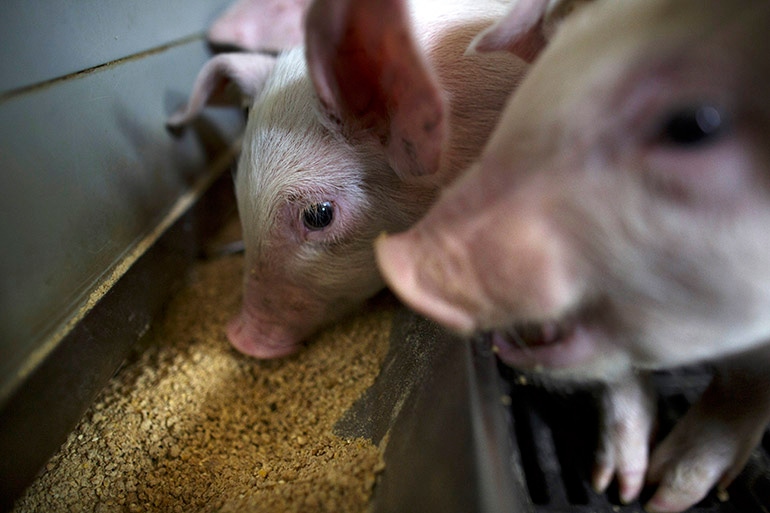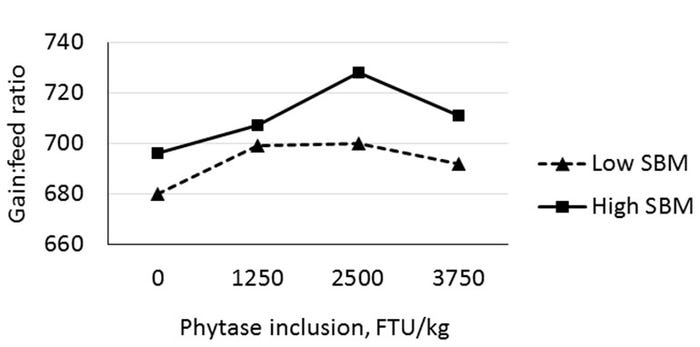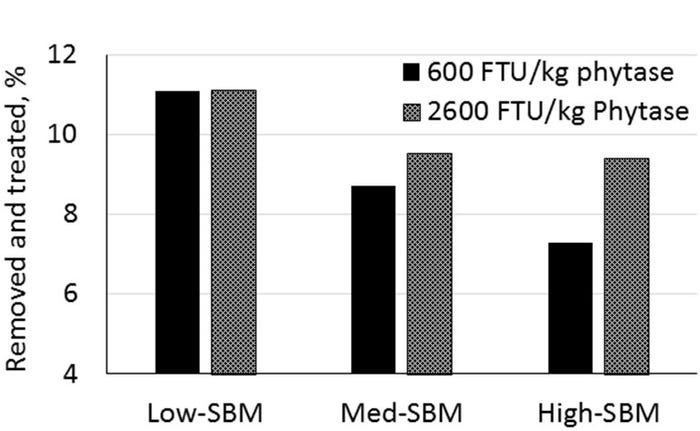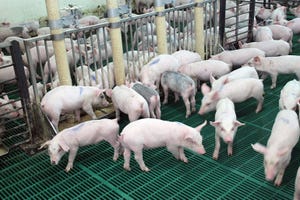Supplementation of phytase at super-dose levels can improve growth performance independently from the level of soybean meal in the diet.
September 14, 2017

By Eric van Heugten and Kory Moran, North Carolina State University; and R. Dean Boyd, Hanor Co.
Super-dosing of phytase can mitigate anti-nutritional effects of phytate and reduce the concentrations of phytate esters by almost complete destruction of the phytate. Although phytase is not often used in nursery diets for young pigs immediately after weaning, it may be a means to mitigate the impact of high phytate levels associated with dietary soybean meal inclusion. This may allow the use of higher levels of SBM (which is typically restricted and gradually introduced due to the unfavorable effects of anti-nutritional factors), thus reducing dependence on alternative proteins that increase diet cost.
Two studies (funded by the United Soybean Board) were conducted in a commercial research facility to determine the impact of high inclusion levels of SBM and phytase super-dosing on performance and health of newly weaned nursery pigs housed under commercial production conditions. In Experiment 1, a total of 2,550 barrows and gilts weaned at 21 days of age were used in a 42-day trial to determine the optimal level of phytase in diets with low and high inclusion levels of SBM. Two SBM levels (low and high) and four phytase doses (0; 1,250; 2,500 and 3,750 FTU per kilogram) were combined to create eight dietary treatments in a 2×4 factorial arrangement. The SBM level in the diet was increased by substantially reducing poultry meal. Pigs were fed a three-phase feeding program, with each period being 10, 10 and 22 days, respectively. Inclusion of low and high-SBM was 15.0 and 25.0% for Phase 1; and 19.0 and 29.0% for Phase 2, respectively, and 32.5% for the common Phase 3 diet.
In Experiment 2, a total of 2,112 barrows and gilts weaned at 21 days of age were used in a 42-day trial to evaluate the potential of high SBM levels in combination with phytase to improve growth and health of weaned pigs derived from a porcine reproductive and respiratory syndrome-positive sow farm. Three SBM levels (low [considered normal in commercial production], medium and high) and two phytase levels (600 or 2,600 FTU per kilogram) were combined to create six dietary treatments. Pigs were fed a three-phase feeding program, with each period being 10, 10 and 22 days, respectively. Inclusion of SBM was 15.0, 22.5 and 30.0% for Phase 1 and 20.0, 27.5 and 35.0% for Phase 2 for low, medium and high-SBM, respectively, and 29.0% for the common Phase 3 diet.
In Experiment 1, no interactions between phytase and SBM on performance were observed. Increasing levels of SBM in early nursery diets by replacing poultry byproduct meal did not reduce growth performance. In fact, pigs fed diets with high SBM had improved feed efficiency (increased Gain:feed ratio; Figure 1), suggesting that SBM is a reliable protein ingredient for early nursery diets.
On the other hand, the reduction in growth performance in pigs fed low-SBM diets may have been due to the inclusion of an inferior poultry byproduct meal, even though a pet-food grade poultry byproduct meal was used in this study. Phytase supplementation improved pig performance regardless of the SBM level (no interactions were observed), and this response was optimal at 2,500 FTU per kilogram.
Similar to the present results, several studies have demonstrated positive effects on growth performance of weaned, grower and finisher pigs when super-dosing phytase.

Figure 1: Impact of super-dosing phytase and level of SBM inclusion on feed efficiency of nursery pigs housed under commercial conditions.
In Experiment 2, it was hypothesized that high levels of SBM may modulate the response of pigs originating from a PRRS-positive sow farm by reducing systemic viral replication and improving growth performance. Soybean products contain isoflavones, which have shown antiviral properties against a wide range of viruses. Increasing the inclusion of SBM did not have any negative effects on daily gain, feed intake or feed efficiency, which was consistent with the results observed in Experiment 1. Increasing levels of SBM linearly reduced (P < 0.05) the number of pigs that were removed from test pens and required medical treatment from 11.1 to 8.4% (Figure 2). The decrease in medical treatments in pigs fed high-SBM levels compared to pigs fed low- and medium-SBM levels represents a positive economic impact in reducing labor cost and medication expenses.
There was no improvement in the percentage of full-value pigs at the end of the experiment, indicating that increased medical treatments in pigs fed low- and medium-SBM diets may have successfully maintained pig weight gain to reach the desired minimum body weight of 11.3 kilograms (25 pounds) at the end of the nursery. High levels of phytase tended to improve fecal scores (P = 0.07) during the first five days after weaning, which may result in less medication costs for loose stools, especially when high levels of SBM are used.

Figure 2: Impact of dietary SBM inclusion level and super-dosing of phytase on the number of nursery pigs removed and treated.
Results from these studies indicate that the level of SBM in early nursery diets can be increased without decreasing growth performance in nursery pigs and it may be favorable in pigs that originated from a PRRS-positive sow farm by reducing costs associated with medical treatment. Supplementation of phytase at super-dose levels can improve growth performance independently from the level of SBM in the diet.
You May Also Like



